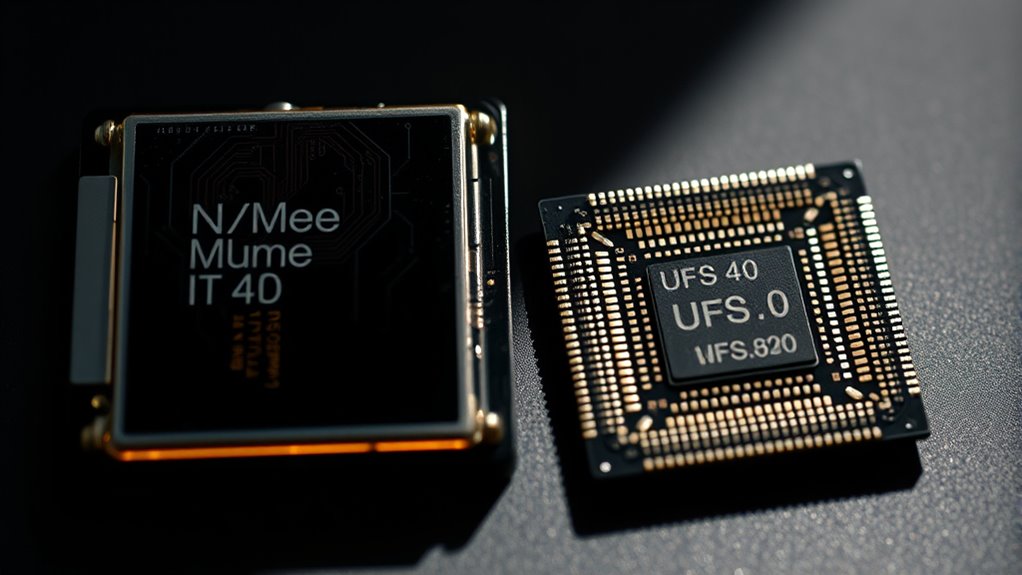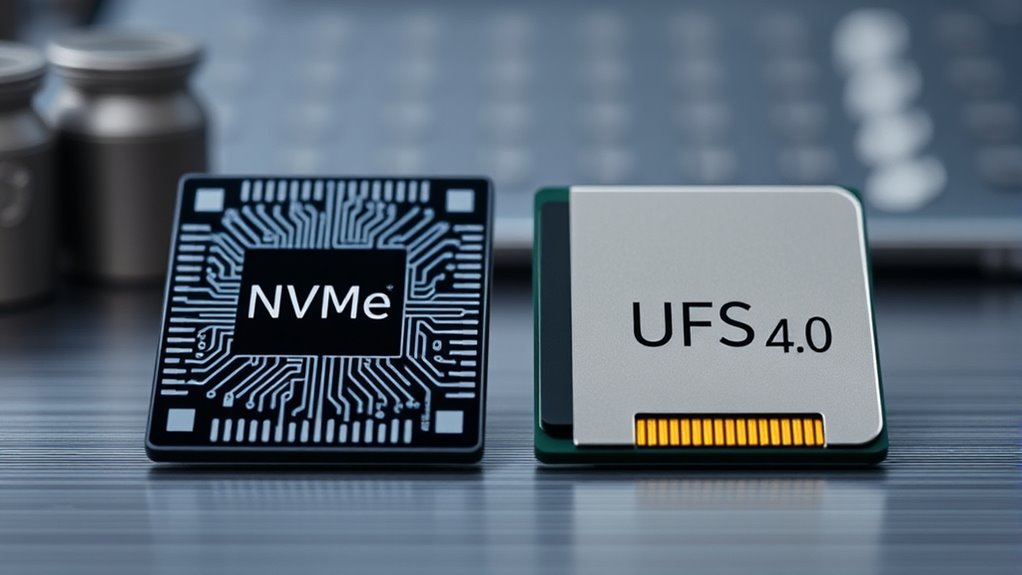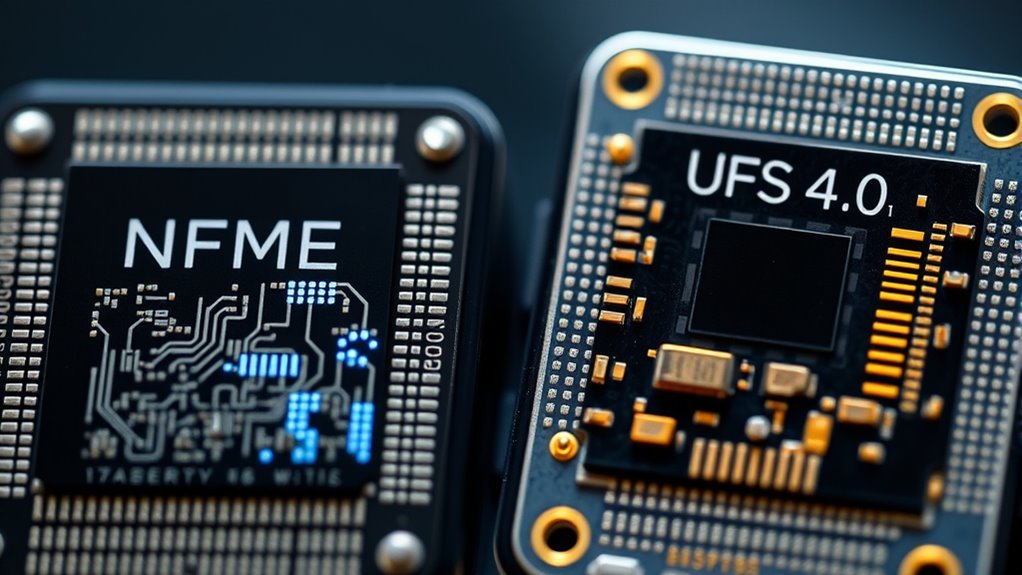NVMe offers faster speeds, up to 7,000 MB/s, but it’s mainly designed for PCs and laptops, making it less common in smartphones. UFS 4.0 balances high performance with energy efficiency and is optimized for mobile devices, providing speeds up to 3,200 MB/s. If you’re choosing storage for everyday use, UFS 4.0 is more practical, but if you need top-tier speed, NVMe’s advantages become more noticeable—if you keep exploring, you’ll uncover what suits your needs best.
Key Takeaways
- NVMe offers higher speeds (up to 7,000 MB/s) but is mainly used in PCs, not common in phones.
- UFS 4.0 provides up to 3,200 MB/s read/write speeds, optimized for mobile device integration.
- NVMe is less compatible with smartphones due to PCIe interface requirements, while UFS 4.0 is designed for mobile form factors.
- Both storage types deliver quick app responses, but NVMe’s speed benefits are more noticeable in large file transfers.
- UFS 4.0 balances performance and energy efficiency, making it the standard choice for modern smartphones.
Understanding the Core Technologies Behind NVMe and UFS 4.0

To understand the differences between NVMe and UFS 4.0, it’s essential to grasp their core technologies. NVMe (Non-Volatile Memory Express) is a protocol designed specifically for high-speed SSDs connected via PCIe lanes. It enables direct communication between the storage device and the CPU, reducing latency and boosting data transfer speeds. UFS 4.0, on the other hand, is a storage standard optimized for mobile devices. It uses a high-speed serial interface and a command queue architecture to improve efficiency and performance. While NVMe relies on PCIe technology and is commonly used in desktops and laptops, UFS 4.0 is tailored for smartphones, offering a compact form factor and energy efficiency. Both technologies focus on accelerating data access but are built for different device ecosystems. Additionally, advancements in storage protocols continue to push the boundaries of speed and power efficiency across various device types.
Performance Benchmarks and Speed Comparisons

When comparing the performance of NVMe and UFS 4.0 storage, speed is a key factor that highlights their distinct capabilities. NVMe generally delivers faster read and write speeds, making it ideal for demanding tasks. UFS 4.0 provides impressive speeds suitable for mobile devices, but typically falls short of NVMe’s raw performance. You’ll notice NVMe’s superior throughput in data-intensive applications like video editing and large file transfers. To illustrate:
| Storage Type | Sequential Read Speed | Sequential Write Speed |
|---|---|---|
| NVMe | Up to 7,000 MB/s | Up to 5,000 MB/s |
| UFS 4.0 | Up to 3,200 MB/s | Up to 2,700 MB/s |
While NVMe outperforms in speed, UFS 4.0 balances performance with power efficiency for mobile use. Additionally, performance benchmarks are essential for accurately comparing storage options.
Compatibility and Device Integration Considerations

Although NVMe drives offer exceptional performance, their compatibility with smartphones is limited due to differences in hardware interfaces and form factors. Most smartphones are built around UFS or eMMC storage, which integrate directly onto the motherboard, making them difficult to replace or upgrade. NVMe drives typically use PCIe interfaces designed for PCs and laptops, not mobile devices, so they aren’t compatible without specialized adapters or custom modifications. Additionally, integrating NVMe drives into phones involves significant design changes, increasing complexity and cost. Manufacturers prioritize compactness and power efficiency, which favors UFS 4.0’s integration. As a result, NVMe drives are generally unsuitable for mainstream smartphones, limiting their use to specialized or high-end devices with custom hardware configurations. The role of storage technology in shaping device performance and design choices further constrains the adoption of NVMe drives in mobile phones.
Practical Impacts on Daily Smartphone Usage

While NVMe drives deliver impressive speeds on computers, their limited compatibility means most smartphone users won’t notice significant performance differences in daily tasks. For everyday activities like opening apps, browsing, or streaming, both NVMe and UFS 4.0 provide quick responses. You’ll mainly see benefits in specialized tasks such as large file transfers or intensive gaming. Additionally, emotional expression and creativity can be supported through optimized storage, especially in devices used for multimedia creation. Consider these practical impacts:
- Faster app load times for large applications
- Quicker file transfers when moving data between devices
- Smoother multitasking during demanding tasks
However, for typical phone use, the difference remains subtle. Most users won’t experience noticeable speed gains, making both storage types suitable for everyday smartphone needs.
Making the Right Choice for Your Mobile Storage Needs

Choosing the right storage for your mobile device depends on how you use your phone and what you prioritize. If speed and quick app loads matter most, UFS 4.0 offers excellent performance, ideal for gaming and multitasking. On the other hand, if you need large storage capacity for videos, photos, or files, consider NVMe options, especially in devices with expandable storage. Think about your daily habits: do you transfer large files frequently or rely on fast app access? Budget also plays a role—UFS 4.0 tends to be more integrated into smartphones, while NVMe is common in high-end and gaming devices. Ultimately, match your storage choice to your needs, balancing speed, capacity, and cost to get the best experience out of your phone. Additionally, understanding the potential pitfalls in adopting new storage technologies can help you make an informed decision.
Frequently Asked Questions
How Does NVME Affect Smartphone Battery Life?
Battery life can be affected by how storage devices operate, especially if they use high-performance interfaces like NVMe. NVMe drives tend to consume more power during intensive tasks because they process data faster, which can lead to quicker battery drain if your phone relies heavily on this technology. However, for everyday use, the impact might be minimal, especially if your device manages power efficiently.
Can UFS 4.0 Be Upgraded After Purchase?
You can’t upgrade UFS 4.0 storage after buying your phone because it’s soldered onto the device’s motherboard. Manufacturers design these storage chips to be permanent, so if you need more space, you’ll have to choose a device with a larger storage capacity upfront. Always consider your storage needs before purchasing to avoid limitations later, as upgrading UFS storage isn’t possible like swapping out a removable SD card.
Are There Security Differences Between NVME and UFS 4.0?
You’re wondering if there are security differences between NVMe and UFS 4.0 storage. Generally, both storage types have built-in security features like encryption and secure boot, but NVMe often targets PCs and enterprise environments, offering advanced data protection. UFS 4.0, designed specifically for mobile devices, emphasizes fast, secure data handling tailored for smartphones. Your choice depends on your device’s security needs and usage context.
Which Storage Type Is More Future-Proof for Smartphones?
Think of your phone’s storage as a crystal ball—predicting the future. UFS 4.0 is more future-proof because it’s designed specifically for mobile devices, offering faster speeds and better efficiency. NVMe, while powerful, is more suited for PCs and data centers. So, if you want your phone to stay ahead of the curve, UFS 4.0 is your best bet for long-term performance and compatibility.
Do Gaming Performance Differences Exist Between NVME and UFS 4.0?
You wonder if gaming performance differs between NVMe and UFS 4.0 storage. Generally, UFS 4.0 offers faster sequential read and write speeds tailored for mobile devices, which translates to quicker load times and smoother gameplay. NVMe, optimized for high-performance desktops and laptops, may not provide significant benefits in gaming on smartphones. So, in mobile gaming, UFS 4.0 typically delivers better performance for your gaming experience.
Conclusion
As you hold your phone, imagine it as a bustling highway — NVMe and UFS 4.0 are the fast lanes. NVMe offers lightning speed for demanding apps, while UFS 4.0 keeps everything flowing smoothly. Choosing the right storage is like picking the best route for your daily ride. With either option, your device becomes a sleek, responsive companion, ready to keep pace with your busy life. Make your choice, and enjoy the ride.









